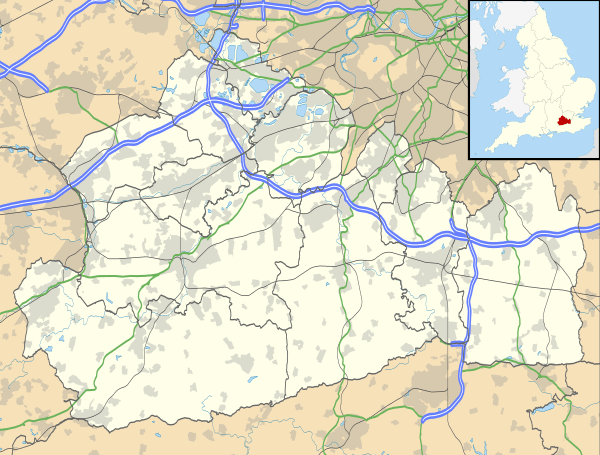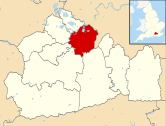Hampton Court railway station
| Hampton Court | |
|---|---|
 | |
 Hampton Court Location of Hampton Court in Surrey | |
| Location | East Molesey |
| Local authority | Borough of Elmbridge |
| Managed by | South West Trains |
| Station code | HMC |
| DfT category | C2 |
| Number of platforms | 2 |
| Fare zone | 6 |
| National Rail annual entry and exit | |
| 2010–11 |
|
| 2011–12 |
|
| 2012–13 |
|
| 2013–14 |
|
| 2014–15 |
|
| Key dates | |
| 1 February 1849 | Opened |
| Other information | |
| Lists of stations | |
| External links | |
| WGS84 | 51°24′10″N 0°20′33″W / 51.4028°N 0.3425°WCoordinates: 51°24′10″N 0°20′33″W / 51.4028°N 0.3425°W |
|
| |
Hampton Court railway station is a suburban terminus railway station in East Molesey in Surrey a few metres short of Hampton Court Bridge the midpoint of which is a boundary of Greater London. Across the river the station serves Hampton Court Palace and its adjoining park-side houses, riverside homes, hotels and boutiques in the London Borough of Richmond upon Thames, and is in Transport for London's Travelcard Zone 6; the station is across the River Thames from Hampton Court Park, Gardens and Bushy Park.
History
It is the terminus of the 1.5 miles (2.4 km) Hampton Court Branch Line, with a junction on the South Western Main Line west of Surbiton. One through station is on the branch, Thames Ditton. The station was built on the island formed between the rivers Mole and Ember and access was via a wooden bridge from Creek Road. The branch was opened on 1 February 1849. In its first two years the carriages were pulled by horses. Regular steam locomotives replaced the horses. By 1868 there were four lines and platforms and a railway turntable as well as coal depot and ancillary buildings on the site. The peak capacity of this station was between 1912 and 1929 when over 10 sets of tracks fanned out at the site; four sets of tracks were designated for shuffle sidings (to augment services to the rest of the network); four were dedicated for the station itself and two lines were goods sidings for goods including bulk materials and the coal depot. During this period a Thames side turntable was removed (the foundations of which were revealed upon redevelopment by Gladedale in May 2013). It is believed the turntable was re-established adjacent to Summer Road and Hampton Court Way.
In the 1930s the bed of the mouth of the Mole was filled in and the stream combined with the River Ember to construct Hampton Court Way and the Edward Lutyens-designed, re-aligned Hampton Court Bridge. The station site is owned by Network Rail and the services operated by South West Trains using the Class 455 fleet.
Services
The typical off-peak service at the station is two trains per hour to and from London Waterloo via Surbiton and Wimbledon, taking 35 minutes for the 13 miles (21 km) journey.
| Preceding station | |
Following station | ||
|---|---|---|---|---|
| Thames Ditton | South West Trains Hampton Court Branch |
Terminus | ||
Infrastructure
Trains use both platforms. Ticket machines are present. The ground floor of the station buildings remains in use. The "Jacobean" style building was designed by Sir William Tite to have ornately-decorated windows and doors. The upper floors are no longer used as station or commercial offices. Painting of the building for the Olympic Cycle event included overpainting the upper floor windows and general repairs.
Disabled access involves platform ramps for kerbs from the pedestrian access from the car park to the pavements and steps from the car park. Passenger waiting areas are external and unheated but under rain proof canopies.
Network Rail have ongoing plans to refurbish the station excluding the upper floors. Recent works include the extension of the platforms to accommodate 10-car trains and refurbishment of the glazing on the late Victorian canopies. There are washroom and toilet facilities at the station. On-platform services include a newsagent, coffee and flower kiosks, capacity for 130 bicycles, and taxi booking offices.
Externally there are the 230, 411 and R68 bus services, drop off zone, coach parking and pay and display car park. Access to the river is available at the footings of Hampton Court Bridge adjacent. Depending on weather and tourist events Parrs Boats operate a ferry service from just north of the station. National Cycle Route 4 passes the station.
The station site bounds the historic "sterte" (peninsular) of Cigarette Island and access to the park can be either from the Car Park or via the riverside.
In the early 2010s at least one modern ticket machine was installed at all South West Trains' stations at which cash and debit/credit cards can be used to purchase tickets cards to any National Rail destination. The machine here can also top up oyster cards.
Platform signs date to 2009 and mirror the understated Southeastern example with white lettering on a navy blue field.
The branch due to its short length has speed restrictions of 40 miles per hour (64 km/h) on the up line and 45 miles per hour (72 km/h) on the down.
Future
Planning permission for the extensive redevelopment of the site was granted in 2009, this expires in June 2013. To date no works have been carried out by the developer. Most recently in May 2013 the planning inspectorate is reviewing the planning condition relating to the rejection of the travel plan. The development proposes a 300 space underground car park with residential and commercial properties above (on the site of the existing car show room and coach park), a 66 bedroom hotel (on the site of, and to the height of, the existing lighting tower), a care home (on the current Network Rail works compound area at the end of the car park) and townhouses (on the existing car park).
As part of the proposed Crossrail 2 infrastructure, Hampton Court has been proposed by business group London First as the terminus for a potential service to Cheshunt via Central London, opening in the "early 2030s".[2]
References
- 1 2 3 4 5 "Station usage estimates". Rail statistics. Office of Rail Regulation. Please note: Some methodology may vary year on year.
- ↑ http://www.bbc.co.uk/news/uk-england-london-21333361
External links
| Wikimedia Commons has media related to Hampton Court railway station. |
- Train times and station information for Hampton Court railway station from National Rail
